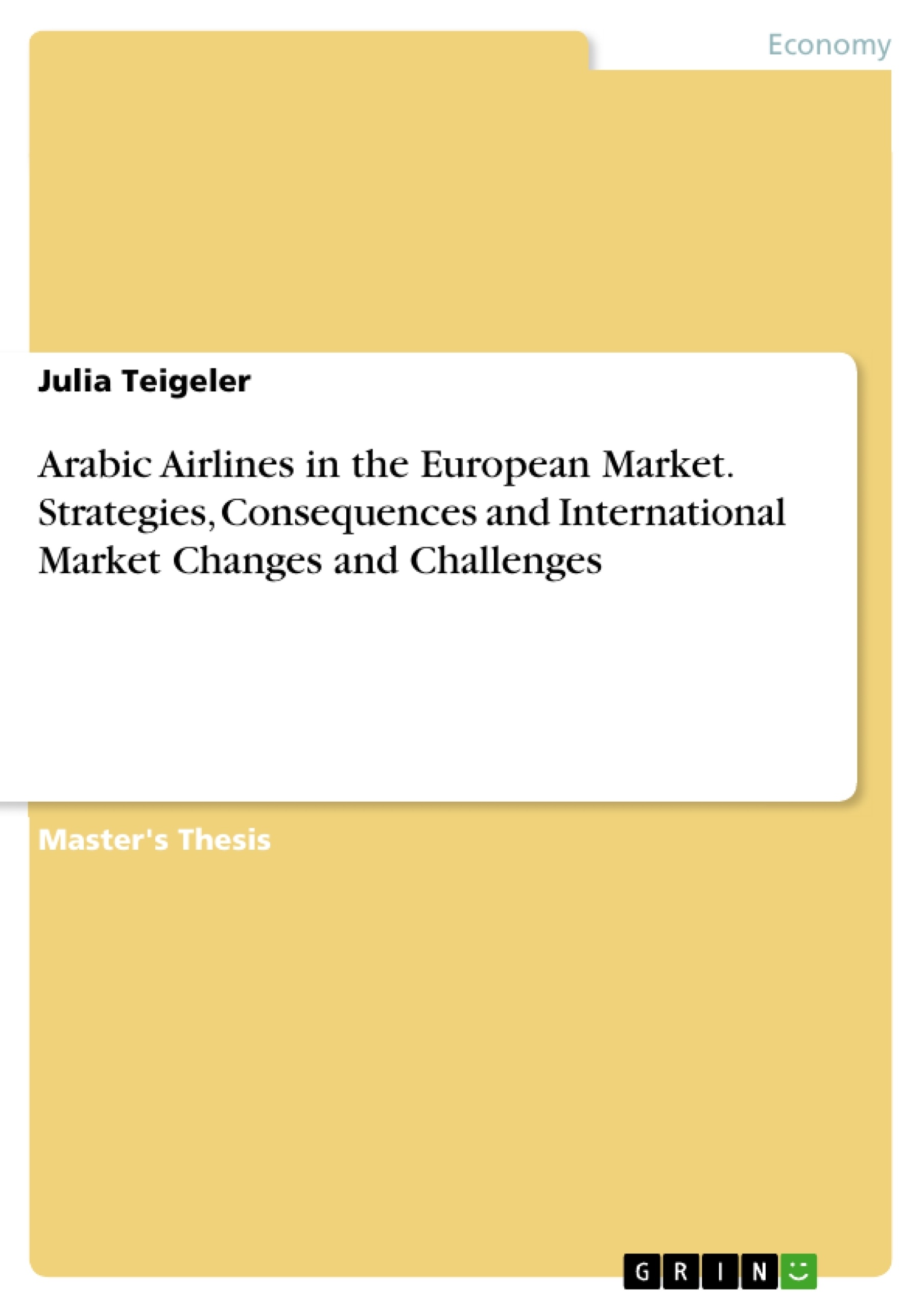In this master thesis, the subject "Arabic Airlines in the European Market - Strategies, Consequences and International Market Changes and Challenges" is accurately represented and analyzed by the author, whereby different methods are used.
The aim of this work is to show the extent to which Arab companies have changed the European airline market in recent years, including the opportunities, possibilities and risks that arise for European and Arab companies. For this purpose, the ten largest companies in the European and Arab market are briefly presented and compared with all key business data. In the Arab market, this includes Qatar Airways, Emirates, Etihad Air-ways, Oman Air, and Saudi Arabic airlines, Gulf Air, Royal Jordanian Airlines, Fly Dubai, Air Arabia and Middle East Airlines. In the European market, the following companies are considered in more detail: Turkish Airlines, Lufthansa, Swiss Int'l Air Lines, British Airways, Austrian Airlines, Air France, Aegean Airlines, KLM, Virgin Atlantic and Finnair. With the help of Porter’s five forces, first the Arabic airlines are analyzed, being closely examined in the following areas: threat of new entrants, threat of substitute products or services, bargaining power of customers, bargaining power of suppliers and intensity of competitive rivalry. Subsequently, the European market is analyzed based upon globalization drivers developed by George Yip. The distinction is made based upon the following points: market drivers, cost drivers, government drivers and competitive drivers.
The results of these investigations highlight that the Arab companies are still very young on the market, only existing on the market for a maximum of a few decades. By contrast, European companies have already been present on the market for much longer. However, the Arabian airlines have very quickly gained enormous market power and large market shares, backed by the vast financial reserves of state-owned enterprises. These companies not only have the financial background that reflects a great advantage over all other international airlines, but also other important advantages that favor a growth in the market. [...]
Inhaltsverzeichnis (Table of Contents)
- Executive summary
- Table of Contents
- List of Abbreviations
- List of Figures
- List of Tables
- 1 Introduction
- 1.1 Problem Definition
- 1.2 Objectives
- 1.3 Structure of the paper
- 1.4 Research Methodology
- 2 Porter's five forces and Globalisation Drivers from George Yip
- 2.1 Porter's five forces
- 2.1.1 Five Forces model
- 2.1.2 Analysis
- 2.1.3 Advantages and Disadvantages
- 2.2 Globalisation drivers of George Yip
- 2.2.1 Globalisation drivers model
- 2.2.2 Analysis
- 2.2.3 Advantages
- 2.1 Porter's five forces
- 3 Information of European and Arabic airlines
- 3.1 Arabic Airline Market
- 3.1.1 Qatar Airways
- 3.1.2 Emirates
- 3.1.3 Etihad Airways
- 3.1.4 Oman Air
- 3.1.5 Saudi Arabic airlines
- 3.1.6 Gulf Air
- 3.1.7 Royal Jordanian Airlines
- 3.1.8 FlyDubai
- 3.1.9 Air Arabia
- 3.1.10 Middle East Airlines
- 3.2 European Airline Market
- 3.2.1 Turkish Airlines
- 3.2.2 Lufthansa
- 3.2.3 Swiss Int'l Air Lines
- 3.2.4 British Airways
- 3.2.5 Austrian Airlines
- 3.2.6 Air France
- 3.2.7 Aegean Airlines
- 3.2.8 KLM
- 3.2.9 Virgin Atlantic
- 3.2.10 Finnair
- 3.1 Arabic Airline Market
- 4 The Influence of Arabic airlines on the European Market Global Strategy of Arabic Airlines
- 4.1 Development of the airline market
- 4.2 Analysis of the Arabic Airlines by Porters five forces
- 4.2.1 Threat of new entrants
- 4.2.2 Threat of substitute products or services
- 4.2.3 Bargaining power of customers
- 4.2.4 Bargaining power of suppliers
- 4.2.5 Intensity of competitive rivalry
- 4.3 Analysis of the European market by George Yip's Globalisation drivers
- 4.3.1 Market globalisation drivers
- 4.3.2 Cost globalisation drivers
- 4.3.3 Competitive globalisation drivers
- 4.3.4 Government globalisation drivers
- 4.4 Market entry Strategies
- 4.4.1 Sprinkler Strategy
- 4.4.2 Waterfall Strategy
- 4.5 Empirical Study
- 4.6 Strategic globalisation forecast planning
- 4.6.1 Boeing
- 4.6.2 Airbus
Zielsetzung und Themenschwerpunkte (Objectives and Key Themes)
This master thesis examines the impact of Arabic airlines on the European airline market. It aims to analyze the strategies, consequences, and challenges posed by these airlines, exploring the opportunities and risks for both European and Arab companies. The work focuses on the largest companies in both markets, providing a comprehensive analysis of their key business data.
- The rise of Arabic airlines and their impact on the European market
- Competitive strategies employed by Arabic and European airlines
- Market dynamics and challenges posed by globalization
- The role of government policies and regulations in the airline industry
- Future prospects and strategic implications for both markets
Zusammenfassung der Kapitel (Chapter Summaries)
The first chapter introduces the research topic, outlining the problem definition, objectives, structure of the paper, and research methodology. Chapter two analyzes the competitive landscape using Porter's Five Forces model and George Yip's Globalization Drivers, providing a framework for understanding the dynamics of the airline market. Chapter three presents detailed information on the largest Arabic and European airlines, examining their key business data and market positions. Chapter four focuses on the influence of Arabic airlines on the European market, analyzing their global strategy and competitive advantages. This chapter also explores the market entry strategies employed by Arabic airlines and examines the implications of globalization for the European market. Finally, the chapter explores the strategic globalisation forecast planning for Boeing and Airbus.
Schlüsselwörter (Keywords)
Arabic airlines, European airline market, competitive strategy, globalization, market dynamics, Porter's Five Forces, George Yip's Globalization Drivers, market entry strategies, strategic planning, Boeing, Airbus.
- Citation du texte
- Julia Teigeler (Auteur), 2015, Arabic Airlines in the European Market. Strategies, Consequences and International Market Changes and Challenges, Munich, GRIN Verlag, https://www.grin.com/document/316547



